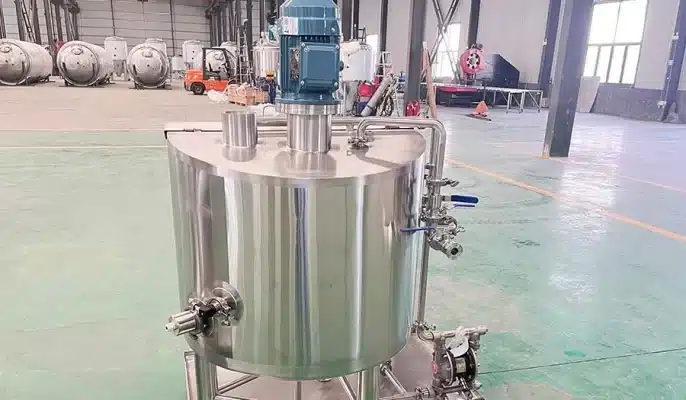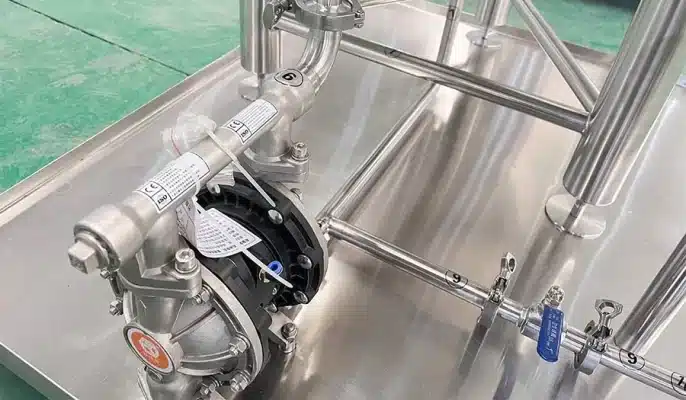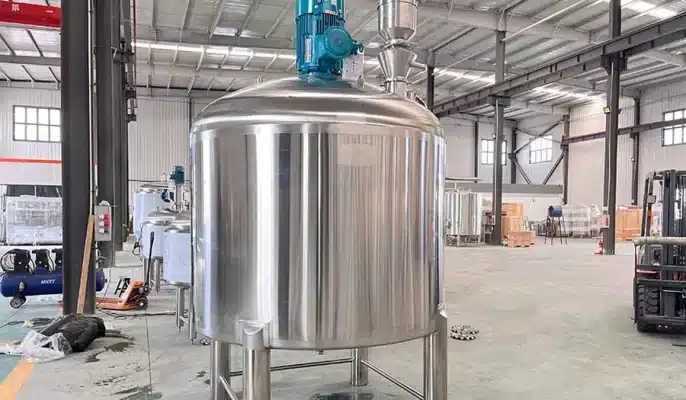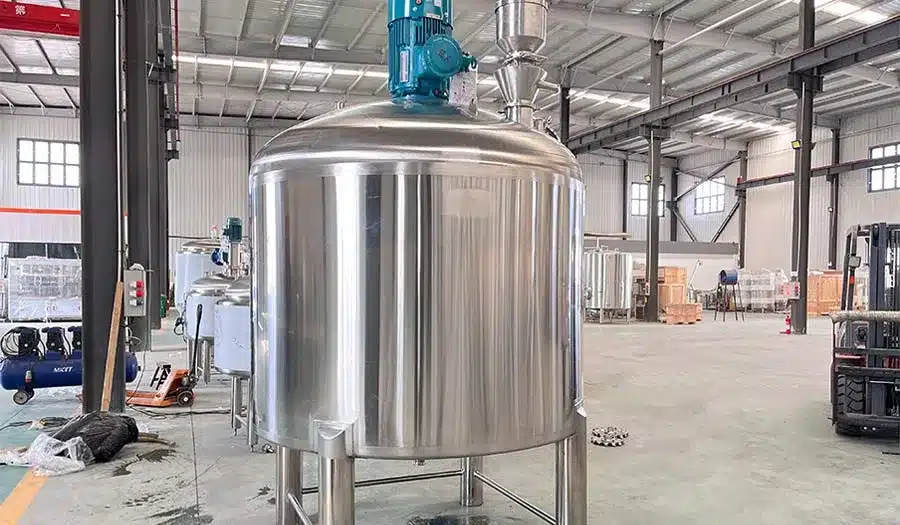A stainless steel mixing tank is a device used to mix and stir liquids. Its core component is the agitator, which achieves the purpose of mixing materials by rotation. The mixing tank can not only improve production efficiency but also ensure the quality and consistency of the final product. Due to its flexibility and adaptability, the mixing tank plays a vital role in the production process in many fields. From the preparation of beverages to the preparation of drugs, and even the production of chemical products, the mixing tank is an indispensable tool for achieving efficient production.
Co je to směšovací nádrž?
A mixing tank is a device specifically used to mix different substances. It is widely used in many industries, such as food, chemical, pharmaceutical, environmental protection, cosmetics, etc. The design and function of the mixing tank can vary according to different production needs. It usually has good sealing, stirring ability and temperature control functions to ensure the efficiency and uniformity of the mixing process.

The main features of míchací nádrže
- Efficient mixing: The mixing tank is equipped with a professional mixing device, which can adjust the mixing speed and method according to the characteristics of the material and the mixing requirements to achieve more efficient material mixing.
- Good sealing: Modern mixing tanks use advanced sealing technology to ensure that any material leakage is prevented during the mixing process, thereby improving safety and reducing waste.
- Corrosion resistance: Most mixing tanks are made of stainless steel or other corrosion-resistant materials, suitable for materials of various chemical properties, and can resist corrosion and wear.
- Temperature control capability: Some mixing tanks are equipped with temperature control systems, which can achieve heating or cooling during the mixing process, thereby controlling the reaction temperature, promoting the smooth progress of chemical reactions, and improving product quality.
- Flexibility and adaptability: The design of the mixing tank can be customized according to different production needs, adapting to a variety of materials and mixing methods, making it widely used in different industries.
- Easy to clean and maintain: The structural design of the mixing tank usually takes into account the convenience of cleaning and maintenance, simplifies the cleaning process, helps to keep the equipment hygienic, and reduces the risk of cross-contamination.
- Intelligent control: Many modern mixing tanks are equipped with intelligent control systems that can monitor mixing parameters such as temperature, pressure, and mixing time in real-time, realize automated operation, and improve production efficiency.
Mixing tank materials
- Stainless steel: Made of food-grade 304/316 stainless steel, it can be used in a wide temperature range, has high physical strength, and is resistant to strong acids.
- PE: Commonly used for corrosives, metal finishing, electroplating, salt water, etc. Strong oxidants, aromatic hydrocarbons, and solvents should be avoided.
- PP: Suitable for a variety of organic chemicals and etching chemicals. Strong oxidants and aromatic or chlorinated hydrocarbons should be avoided.
- Carbon steel: Carbon steel is also a common material in some less corrosive environments. Although its corrosion resistance is not as good as stainless steel, it has high strength and relatively low cost, making it suitable for some basic mixing applications. Before use, it is usually treated with a surface coating to increase corrosion resistance.
- FRP: FRP is a composite material with lightweight, high strength, and good corrosion resistance, suitable for mixing in some special environments. It is widely used in the chemical industry, especially for mixing corrosive materials.
- Plastics: Plastic materials such as high-density polyethylene (HDPE) or polypropylene (PP) may be used in some applications. These materials are lightweight, corrosion-resistant, and suitable for relatively mild environments and mixing of certain chemicals.
- Ceramics: In some high-temperature or special chemical environments, ceramic materials can be used to manufacture mixing tanks because they have excellent high-temperature and corrosion resistance, but they are relatively heavy and fragile.
- Coating materials: The inner wall of some mixing tanks can be coated with special coatings, such as polyurethane coatings or fluorinated coatings, to enhance their corrosion resistance and easy cleaning. This design is suitable for production environments with special needs.

What are mixing tanks used for?
Potravinářský a nápojový průmysl
In the food and beverage industry, mixing tanks are particularly widely used. They can be used to prepare a variety of beverages, such as juices, dairy products, sauces, etc. In these processes, mixing tanks can not only provide a uniform mixing effect but also maintain the quality and taste of the product. For example, when making juice, mixing tanks can help evenly mix different types of juice to ensure that each bottle of juice can maintain a consistent taste and color.
Chemický průmysl
In the chemical industry, mixing tanks are often used to synthesize products such as chemicals, coatings, and resins. By precisely controlling temperature and pressure, mixing tanks can promote chemical reactions to produce the desired compounds. In addition, the design of mixing tanks can adapt to materials with high viscosity, corrosiveness, and other special properties to ensure the safety and efficiency of the production process.
Farmaceutický průmysl
The pharmaceutical industry has extremely high requirements for product quality. Mixing tanks are mainly used in this field for the preparation and mixing of drugs. By using mixing tanks, pharmaceutical companies can evenly mix active ingredients with excipients and ensure the consistency of the ingredients of each dose of medicine, which is crucial to ensure the efficacy of the medicine. In addition, the cleaning and disinfection functions of the mixing tank can also ensure the sterility of the production environment, meeting the strict standards of the pharmaceutical industry.
Environmental protection industry
In the field of environmental protection, mixing tanks can be used in wastewater treatment and sludge treatment processes. For example, in wastewater treatment, mixing tanks can be used to add chemicals and promote the precipitation and removal of harmful substances in wastewater by adjusting the mixing ratio. Through effective mixing, the environmental protection industry can improve treatment efficiency and reduce wastewater treatment costs.
Cosmetic industry
The cosmetics industry also relies on mixing tanks for the preparation and emulsification of different ingredients. When producing skin care products, shampoos, or cosmetics, mixing tanks can ensure that various ingredients are evenly dispersed and stable. In addition, as consumers’ demand for natural and organic products increases, the flexibility and adjustability of mixing tanks make small batches and multi-variety production possible.
Mixing principle of mixing tank
The mixing principle of a mixing tank is mainly to achieve uniform mixing of different materials through physical mechanical force and fluid mechanics. The following are the basic principles and processes of mixing in a mixing tank:
- Type of agitator: Different types of agitators (such as paddle, spiral, anchor, turbine, etc.) will produce different flow patterns and shear forces to adapt to different material properties and mixing requirements. For example, paddle agitators are suitable for mixing high-viscosity materials, while turbine agitators are suitable for mixing low-viscosity liquids.
- Principle of fluid mechanics: When the agitator rotates, shear force and pressure difference will be generated in the liquid, causing the liquid to flow. This flow will form vortices, which promote interaction and mixing between materials.
- Shearing action: When the agitator rotates, the liquid in the mixing tank is affected by shear force. The shear force causes large particles to disperse into small particles, thereby achieving more uniform mixing, which is especially important when mixing solid particles and liquids.
- Convection and diffusion: During the mixing process, the convection movement of the liquid helps the transportation and distribution of materials. Under the action of the agitator, the material forms a convection ring flow, which promotes the diffusion and uniform distribution of different components.
- Bubble and gas fluidization: In some applications, the mixing tank can introduce gas to form bubbles to increase the gas-liquid contact area and promote the mixing reaction process (such as fermentation). The flow rate of the agitator and the way the gas is introduced will affect the formation and dispersion of bubbles.
- Temperature and reaction control: In some mixing processes, temperature is also an important factor affecting the mixing effect. Increasing the kinetic energy of the material through the movement of the agitator, thereby increasing the temperature, helps to accelerate chemical reactions or improve the fluidity of the material.

ČASTO KLADENÉ DOTAZY
Co je to směšovací nádrž?
A mixing tank is a device used to evenly mix different materials such as solids, liquids, or gases. It is usually equipped with an agitator to achieve effective mixing and reaction of materials.
What are the main application areas of mixing tanks?
Mixing tanks are widely used in industries such as chemicals, pharmaceuticals, food and beverages, coatings and paints, daily chemicals, and environmental protection treatment.
What are the considerations for the material selection of mixing tanks?
The material of the mixing tank should be selected according to the application environment and material characteristics. Common materials include stainless steel, carbon steel, plastic, and fiberglass. Stainless steel is most commonly used due to its corrosion resistance and high-temperature resistance.
What aspects of the maintenance of the mixing tank should be paid attention to?
- Pravidelné čištění
- Check the agitator and seals
- Monitor temperature and pressure
- Regularly check and maintain the agitator




